Previous - Portraits of Emperors on Chinese Coins
Portraits of Sun Yat-sen on Chinese coins
After the Xinhai Revolution, the country was divided, with
two different governments in the north (Beijing) and the south (Nanjing), and
one part of China trying to subjugate the other. In the provinces, the wujun
enjoyed complete autonomy, and each of them also tried to seize more power.
After the revolution, Chinese coins began to bear minting dates that were
counted according to the revolutionary calendar, i.e. from the Xinhai Revolution
(October 1911) or from the proclamation of the republic (January 1912).
Therefore, when dating coins by different authors, the numbers can often differ
by a year.
First, let's talk about coins that depict legally (and not so much) elected
heads of state who represented the Beijing government, i.e. the north of China.
The victory of the Xinhai Revolution was preceded by an
armed uprising initiated by the Union for the Revival of China, created by Sun
Yat-sen. This uprising took place in Guangzhou (Canton) in October 1895, but was
defeated and almost all of its organizers and immediate participants were
executed.
After this, Sun Yat-sen was forced to emigrate abroad, first to Japan, where he
cut off his braid as a sign of the beginning of the struggle against the Manchu
dynasty, then to the United States, and from there to London. There he was
arrested by representatives of the Chinese embassy and only thanks to the
intercession of his friend Dr. Cantlie and the intervention of Lord Salisbury,
Sun Yat-sen was released, and he left again for Japan. He stayed there until the
beginning of the armed uprising in Wuchang in October 1911, and then returned to
China.
On October 29, 1911, in Nanjing, a conference of provincial representatives
elected Sun Yat-sen as president. He became the first (temporary) president of
the Chinese Republic for the period from January 1 to April 1, 1912.
After this, power passed to Yuan Shikai. The latter held the post for about two
years, after which he decided to proclaim himself emperor. This venture failed
and in 1916, Yuan was forced to leave the political arena.
In August 1912, Sun Yat-sen created the National Party - Kuomintang and the
following year raised an uprising against Yuan Shikai, but was defeated and
again forced to emigrate. In 1917, he returned to China and established his own
government in Guangzhou, but he did not receive support there and was again
forced to hide, this time in Shanghai.
Sun gained power in Guangzhou only with the formation of his government in 1923.
However, this government was not recognized by anyone.
During this period, Sun began to actively cooperate with the USSR. Thus, in
August 1923, he sent a parliamentary delegation of China headed by Chiang
Kai-shek to Moscow. The USSR provided military assistance, although not in the
amount requested by Sun Yat-sen.
"MEMENTO" coins
The approval of the final version of the issue of the first republican coins was preceded by the minting of numerous trial ones. Coins were issued in denominations of 1, 5 cash, 1 wen (10 cash) made of copper, 10 cents (100 wen, 1 jiao), 20 cents (200 wen, 2 jiao), 50 cents and one dollar (100 cents) made of silver.
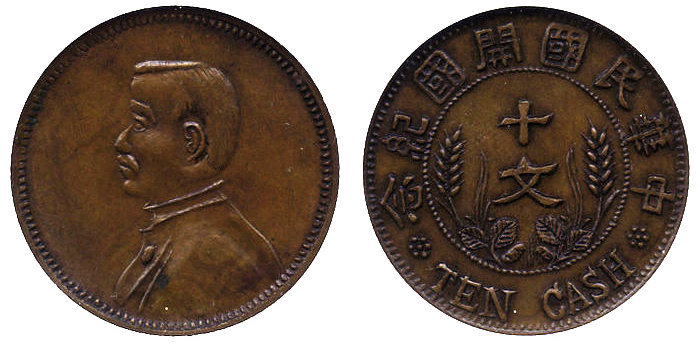
10 cash Sun Yatsen, copper, 1912
The obverse of the silver coins featured a portrait of Sun
Yat-sen and inscriptions in Chinese (國民華中 – “Republic of China” and 開國紀念幣 –
“Commemorative state coin in circulation”) and in English “MEMENTO / BIRTH OF
REPUBLIC OF CHINA”. Dollar coins of the same design were minted, but with the
inscription “THE REPUBLIC OF CHINA / ONE DOLLAR”.
On the reverse of
the 10-cent coin, at the top there is an inscription: 一角 MEMENTO 书 – “One jiao”
and in the center: 十枚壹圓 – “10 (such) coins make one yuan” (Fig. 9). Currently,
the price of this coin reaches 10,000 dollars. Coins of 10 cash, 20 cents and
one dollar denominations were also issued in gold for presentation purposes.
As a result, of all the coins of the trial mintage, only silver coins of 1
dollar and 10 cents (known among numismatists as the MEMENTO series) were
released into circulation. They were minted in Nanjing or Tianjin.
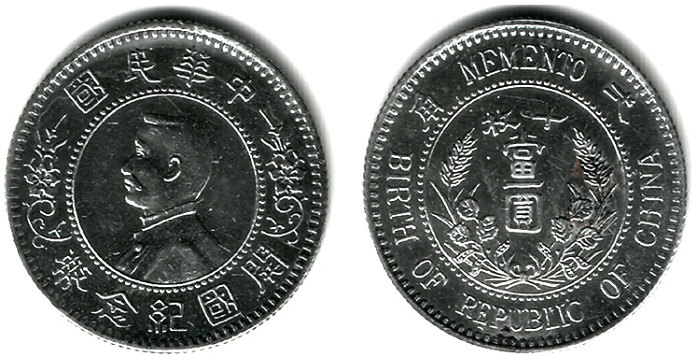
10 cent coin. Sun Yat-sen, silver, 1912
The second version of the dollar coin, without the MEMENTO
inscription, was minted in a limited edition, is rare and costs around
3,000–4,000 dollars.
The outwardly simple dollar coins, however, are full of Chinese symbolism. Thus,
they are characterized by an unusual spelling of the hieroglyph min (“people”):
the right leg of which reaches the very top of the hieroglyph and even protrudes
slightly, which differs from its classical spelling (民).
Some Chinese numismatists explain this as follows: in China there is an
expression 出头 (chū tуu), which can be translated as “raise your head, free
yourself.” Thus, the unusual spelling The hieroglyph 民 symbolizes the liberation
of the Chinese people as a result of the revolution.
At the 3rd and 9th o'clock positions on the obverse, there are rosettes in the
form of plum blossoms - a traditional symbol of courage and hope in China. They
also symbolize the "principle of five powers" put forward by Sun Yat-sen. These
are five areas of government activity, including legislative, executive,
judicial and examination powers, as well as control bodies.
On the obverse and reverse, there are ears of wheat, symbolizing the abundance
of food in the country. Above the ears of wheat are three leaves, i.e. Sun
Yat-sen's three national principles (nationalism, democracy and welfare).
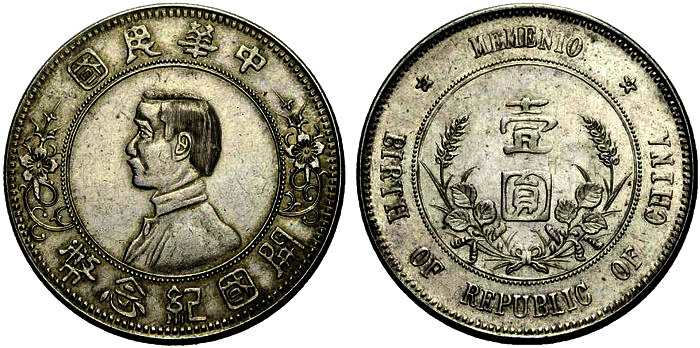
One Dollar. Sun Yat-sen, Silver, 1912
The coins of 1912 did not circulate for long, and their
issue was discontinued the following year. Yuan Shikai became president.
The second issue of dollar coins with the image of Sun Yat-sen appeared in the
late 1920s, after his death. The coins minted in 1927–1929 with a denomination
of one dollar were no different from the coins of 1912 in circulation, except
that the legend on the reverse was divided by two six-petal rosettes instead of
stars.
A huge number of varieties of these coins are known,
differing in the length of the leaves on the ears, in the details of the flower
pattern on the right and left, in the presence or absence of a dot above the
hieroglyph 圓 "yuan". Such a large number of varieties is explained by the fact
that the coins were minted at several mints (in Hangzhou, Nanjing, Tianjin,
Wuchang, as well as in the provinces of Shenyang and Sichuan) and each mint had
its own dies. It should also be borne in mind that these dollars were re-minted
in Canton in 1940 and under the communists in Chengdu in 1949.
Since the population was reluctant to accept dollar coins because of their small
portrait, an attempt was made in 1929 to mint a memorial dollar with an enlarged
portrait of Sun Yat-sen, but these coins were not put into circulation.
Dollar coins from the MEMENTO series are often used to make jewelry, decorate
dishes, etc. The MEMENTO series also includes trial coins of 10 cash (1 wen)
denomination, minted in gold and copper. Just like the previously described
ones, these coins were intended for presentations. However, some numismatists
classify them as fantasy coins. Finally, it is worth noting the dollar coin
minted with a later reverse stamp (from the yuan "with a junk"), as well as the
re-minting of the Yuan Shikai dollar.
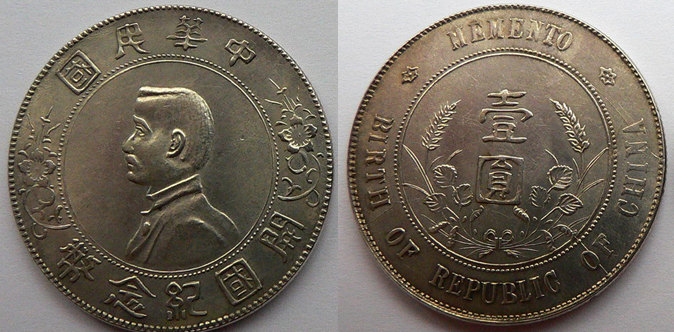
One Dollar. Sun Yat-sen, Silver
In 1925, Sun Yat-sen fell ill with cancer and died in Beijing at the age of 58. He left a will to bury him in Nanjing on the slope of Mount Zijinshan, near the mausoleum of the founder of the Ming Dynasty, Emperor Taizu (Zhu Yuanzhang, 1368–1399).
Coins issued after the death of Sun Yat-sen
While the mausoleum was being built, the Viennese engraver Richard Placht was
cutting dies for the release of a special silver coin with a face value of one
dollar. According to the Chinese, the coin was unsuccessful.
The construction of the mausoleum lasted three years, and therefore its image on
the coin was very different from the modern appearance of the building.
In addition, an official representative of the Nanjing Mint stated that Sun Yat-sen
in the portrait looked more like General Paul von Hindenburg than like himself.
Therefore, the dollar was minted at the Nanjing Mint only in limited quantities
(only 480 pieces), which were distributed among the people who took part in the
reburial of Sun Yat-sen in 1929.
On the obverse of the coin is a portrait of Sun Yat-sen and the inscription:
府政民國國民華中 "Government of the Republic of China". Later, this coin was minted in
copper (unofficial issue).
On the reverse of both coins is the year of minting: 造年六十 "Minded in the 16th
year (of the Republic), 1927" and the denomination "One yuan". Today, the price
of a silver coin "Sun Yat-sen Mausoleum" reaches 25,000 dollars.
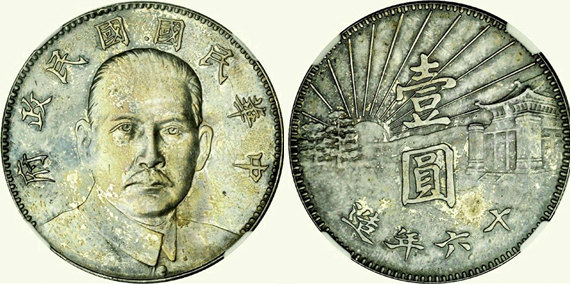
One Dollar. Sun Yat-sen, Silver, 1927
Along with the already described second issue of dollar
coins with the portrait of Sun Yat-sen of the MEMENTO series, silver coins of 1
and 2 jiao (10 and 20 cents) were minted in the same year. Numismatists called
this issue "In Memory of Sun Yat-sen". On the obverse of all coins is a portrait
of Sun Yat-sen and the legend: 造年六十 * 幣念紀理總 * 國民華中 (Republic of China * Coin of
Remembrance of the Eternal Principles * Minted in the 16th year of the Republic
(1927). This refers to the three principles of the people proclaimed by Sun Yat-sen,
which were mentioned above.
On the reverse are two crossed flags - the Kuomintang and the Republic of China,
the denomination and the inscription: 圓一當枚五(十) 每 - "Every five (ten) coins make
one yuan."
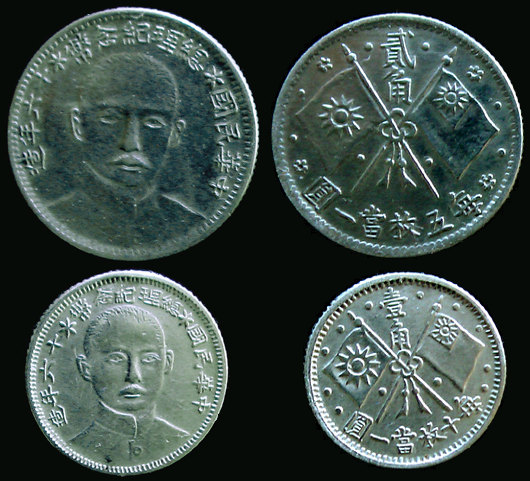
Coins of 1 and 2 jiao. Sun Yat-sen, silver, 1927
The 2 jiao coin was also issued with a modified portrait,
reminiscent of the portrait on the MEMENTO dollar, but it was limited to a trial
issue.
A trial issue of the coin is also known with a denomination of one jiao, minted
in copper. At the same time, the copper coin with a denomination of two jiao,
apparently, belongs to the number of fantasy ones.
Trial silver dollar coins with a large portrait of Sun Yat-sen, minted in the
18th and 19th years of the Republic (1929; 1930), are very rare.
However, according to some numismatists, the coin of 19 is considered to be
fantasy. The reverse of both coins depicts two crossed flags at the top of the
globe and the denomination is indicated below.
At one of the recent auctions in Hong Kong, a silver dollar of 18 was sold for
178,000 dollars. A fantasy coin of 18, minted in copper, is also known. Another
dollar, minted with the Yuan Shikai coin reverse stamp, is probably also a
figment of fantasy.
Coins with Sun Yat-sen's portrait were also minted in the
provinces. For example, in 1929, silver coins of 1 and 2 jiao (20 and 10 cents)
were issued in Guangdong Province. These coins are quite common.
At the bottom of the reverse side is the inscription: 造省東廣 – "Minted in
Guangdong Province". Even during Sun Yat-sen's lifetime, in 1924, a coin of 2
jiao was minted in gold and was intended for presentation purposes.
A rare copper coin of 1 cent, minted in the same province in the 25th year of
the Republic (1936). On the reverse side of the coin, the province and
denomination are indicated in the center: 廣東一仙 "1 cent (of the province)
Guangdong". At the bottom is the inscription: 元一錢枚百每 "100 of these coins make 1
yuan." The auction price of this coin reaches 4,000 dollars.
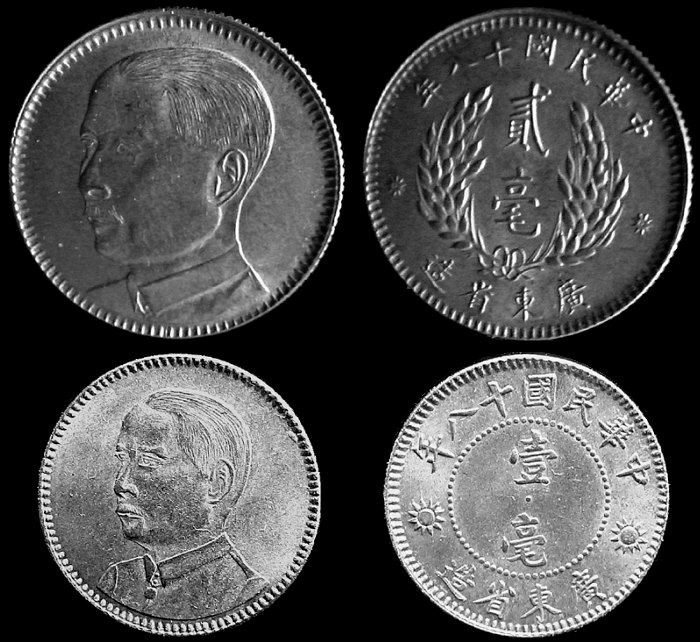
1 and 2 jiao coins (Guangdong Province). Sun Yat-sen, silver, 1929
Another rare example is the trial silver coin of 5 jiao (50
cents), minted in the 17th year of the Republic (1928) in Sichuan Province,
which is indicated by the inscription on the obverse at the bottom: 川四 Szechuan
"Sichuan Province". The cost of this coin is about 5,000 dollars.
One-dollar coins are known, minted in silver and copper in Gansu Province in
1928. On the reverse at the top it is indicated that both coins were minted in
Gansu Province: (甘肃 省造). The same is indicated at the bottom in Mongolian. The
price of a silver coin of one dollar is 25,000 - 30,000 dollars.
There is information that a gold coin of 10 dollars was issued in the same
province. Gansu also minted a copper coin worth five mei (five cash) (伍枚). All
Gansu coins bore the Kuomintang emblem, the 12-pointed star, on the reverse. In
1930, Shandong Province minted a silver dollar with the same portrait of Sun Yat-sen
as the 1927 coin, but with a different reverse stamp.
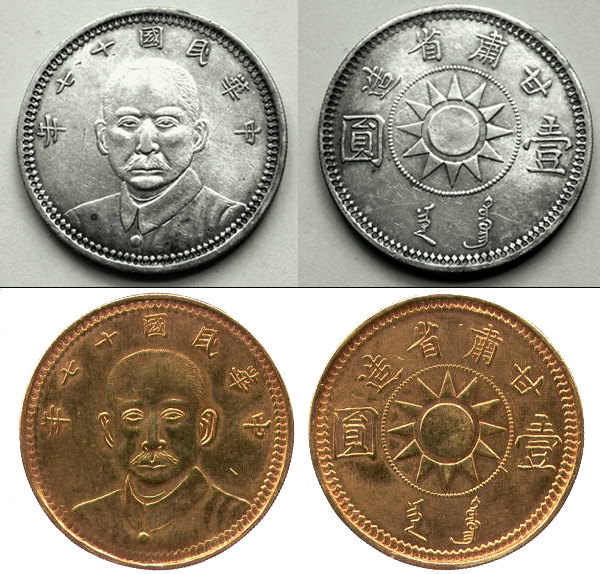
One dollar (Gansu province). Sun Yat-sen, silver, copper, 1928
Coins with a sailing junk
In 1929, the Chinese government decided to issue a new type
of dollar coin with a portrait of Sun Yat-sen on the obverse and an image of a
sailing junk on the reverse.
Several mints in Europe and the United States were contacted to make the stamp.
A competition was announced, based on the results of which it was planned to
make a decision on placing the main order.
Trial coins were minted at mints in Austria, Italy, England, Japan and the
United States, which explains the existence of a huge number of rare varieties
of this coin.
Numismatists called this issue the "dollar with a junk". Coins minted at
different mints differ in the details of the portrait of Sun Yat-sen, as well as
in the features of the image of the sea.
As a result, the design of the coin with the image of a junk was approved, but
against the background of the rising sun and flying geese, and in 1932, more
than 2 million of these coins were minted. Of this print run, about 50,000 coins
entered circulation.
Trial coins minted in copper are also known.
However, the following complication unexpectedly arose. In 1931, Japan invaded
Manchuria, and a few years later, the full-scale Second Sino-Japanese War broke
out. For the Chinese, the rising sun began to symbolize aggressive Japan, and
seagulls in the sky evoked bad associations with Japanese air raids on Chinese
cities.
As a result, these coins had to be abandoned and the remainder of the print run
was sent for remelting.
In the following three years (1933, 1934 and 1935) the coins were minted without
the sun and seagulls, and the trial coins were again minted in copper.
These coins became so popular that they were issued in very large print runs: 46
million in 1933 and an additional 128 million in 1934.
Later, already under the communists, about 30 million more coins with the date
1934 were minted at three mints in the USA. Therefore, the coins of 1934 are
often encountered. The coins of 1936 were issued in limited quantities and are
rare (their price reaches 55,000 dollars), and in general the price of numerous
trial coins of the "dollar with a junk" fluctuates between 5,000 and 17,000
dollars.
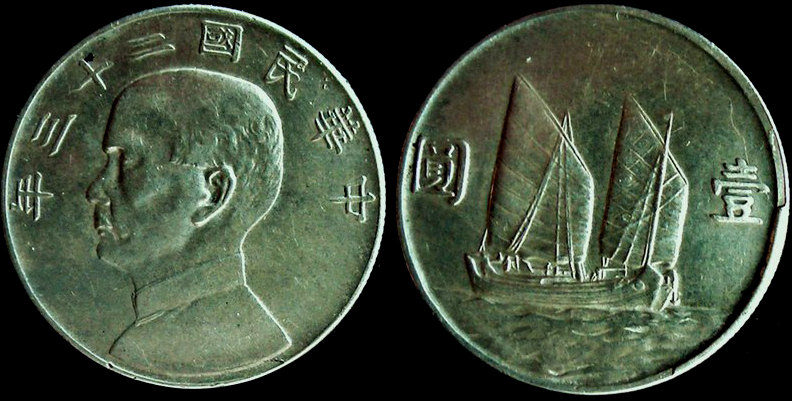
One dollar. Sun Yat-sen, silver, 1934
In 1929 and 1932, along with the dollar, it was planned to
issue coins of the same design in denominations of 50, 20 and 10 cents.
There are known coins of 1 dollar and 50 cents minted in Vienna and in London.
On the reverse of the coin of denomination of 50 cents minted in Great Britain
is the inscription 圓半幣位本金 "Coin in the gold standard equal to half a yuan".
On the Vienna coin, the denomination is indicated on the sides of the reverse.
Also in Vienna, trial coins of 10 and 20 cents were minted from nickel. On the
reverse of the coin of 20 cents is the inscription 毫貳幣位本金 "Coin in the gold
standard equal to two jiao". The 10 cent coin has the denomination 壹角 "one jiao"
written on the sides of the reverse. These coins are extremely rare and their
auction prices reach $40,000 - $70,000.
The popular "junk dollar", especially the 23rd mintage (1934), was widely used
for decorative purposes.
An interesting commemorative coin was issued to mark the end of World War II.
The reverse side has a countermark painted in red: 利勝盟同 "Joint triumph of the
allies". A small number of coins were countermarked and they are quite rare,
although they are not very valuable.
Commemorative medal
In 1930, a commemorative silver medal was issued to mark the completion of the
reconstruction of the Shanghai Mint and its transformation into the Central
Mint. The dies were cut by engraver Clifford Hewitt, who placed his initials on
the coin.
The medal resembles the "junk dollar" minted in 1932, but without the
denomination and with circular inscriptions on the obverse and reverse sides.
The inscription on the obverse reads: 中華民國 * 中央造幣成工? 紀念 * 吞年九 "The Republic of
China * Commemorative medal on the occasion of the opening of the Central Mint *
Functioned for nine years" (referring to the Shanghai Mint). The reverse has the
same inscription in English with the year and place of minting.
The Shanghai Mint began issuing coins in 1920, and in 1928 it was transformed
into the Central Mint. It was on this occasion that this medal was struck, which
is valued at 10,000 dollars.
In the 1930s, silver dollars with a portrait of Sun Yat-sen were also issued,
the same type as those described above, which were called "testament dollars".
Kuomintang coins with the portrait of Sun Yat-sen
The last issue of republican coins with a portrait of Sun Yat-sen took place in
the mid-1930s, when the Kuomintang party had already come to power in China.
In 1936, the country issued bronze coins of 1/2 cent denomination with the
Kuomintang emblem (12-pointed star) on the obverse, as well as large coins with
a hole in the denomination of 1 cent (1 fen) (the so-called "Kuomintang issue").
These coins did not have portrait images on the obverse.
On the reverse of the 1/2 cent coin, in the center, there was an image of an
ancient Chinese spade coin dating back to the 4th-3rd centuries BC with an
inscription on the sides (from right to left): 齊貝 meaning "equivalent to a
cowrie", which in ancient China certified the legality of using a spade coin,
and also served as a denomination.
In the same year, it was planned to issue nickel coins of 5, 10, 20 cents, as
well as 50 cents and 1 dollar made of silver. On the obverse of these coins,
instead of the Kuomintang star, there was a portrait of Sun Yat-sen and the name
of the country: 國民華中 – "Republic of China", with the date: 二十五年 – "25th year of
the republic"; 1936.
The reverse remained unchanged, i.e. the same as on the coin of 1/2 cent
denomination of the Kuomintang issue (the image of a spade coin).
Silver coins of 50 cents and one dollar were not put into circulation.
Copper-nickel coins of 50 cents denomination appeared only in 1942, and the
dollar remained a trial coin.
The first issue of nickel 5, 10 and 20 cent coins was minted in Vienna and the
reverse of these coins bears the mint mark of the Vienna mint.
The final issue of coins was preceded by the minting of numerous trial pieces
made of brass, copper, aluminum, aluminum bronze and even lead. The main issue
of coins was minted in Shanghai from pure nickel and therefore they are
attracted to a magnet.
At the same time, the opponents of Chiang Kai-shek, who had settled in Tianjin,
minted 10 cent coins in 1936 from an alloy with such an insignificant nickel
content that these coins were not attracted to a magnet. A total of 1 million of
these non-magnetic coins were minted (for comparison, the circulation of the
Shanghai issue was almost 74 million pieces) and they are rare. The coins were
minted in 1936 and again in 1938 and 1939. An additional issue of 5, 10 and 20
cent coins took place in the early 1940s.
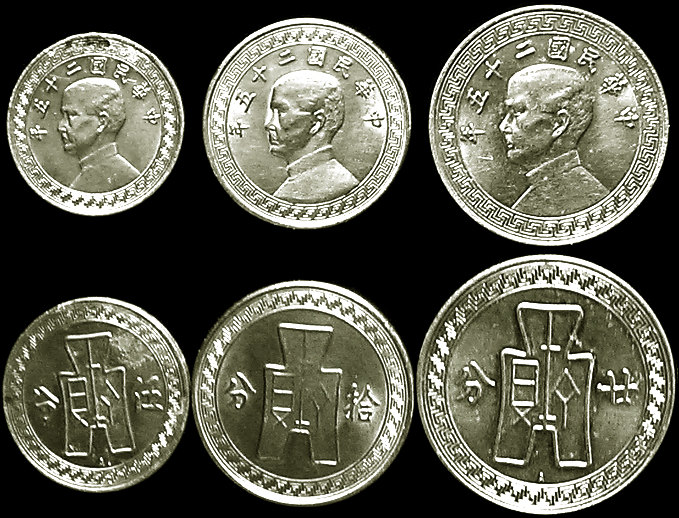
Coins of 5, 10 and 20 cents. Sun Yat-sen, nickel, 1936
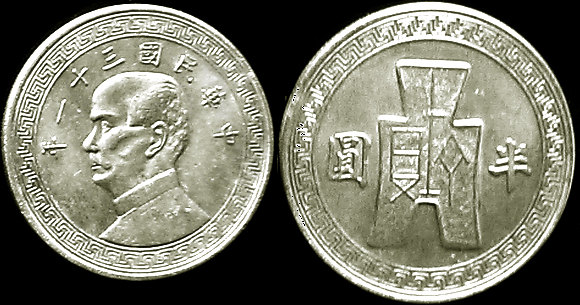
50 cent coin. Sun Yat-sen, copper-nickel alloy, 1942
In the early 1940s, attempts were made to mint some
denominations from copper and brass, but they did not go beyond trial samples.
Trial coins also include 10-cent coins, on which one or two characters 准 (zhŭn)
or 平 (píng) are placed on the sides of the portrait. These coins are rare and
highly valued by collectors.
After 1949, commemorative coins and medals with a portrait of Sun Yat-sen were
repeatedly issued in the PRC and Taiwan. In terms of design style and engraving
quality, they are close to European ones, but their consideration goes beyond
the scope of the designated historical period.
Part three - Portraits of Yuan Shikai

